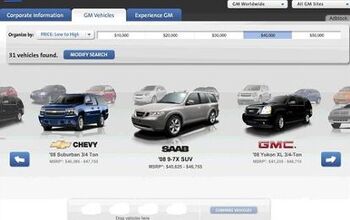General Motors Death Watch 13: Steady as She Goes
'We aren't going out of business in the next six months.' After yesterday's stockholder meeting, GM Chairman Rick Wagoner faced reporters and jokingly predicted that his company will last until November– just in time for the long-delayed launch of the new Pontiac Solstice. The irony would be delicious if there weren't so many diners at the table. GM's continuing slide threatens the financial future of hundreds of thousands of shareholders, workers, suppliers, dealers, even the Seven Million Dollar man himself. And yet Wagoner's "big idea" to revive The General's declining health is a sham.
While Wagoner unveiled a five-point plan for GM, the headlines focused on plant closures and screamed "GM to slash 25,000 jobs!" The Chairman's committment to downsizing was a guaranteed spin winner. You know the drill: American manufacturing jobs are disappearing. It's a crisis! Something must be done! Equally important from Wagoner's POV, there's a market-pleasing corollary: times are tough, but GM is taking tough action. News of the move sent GM's share price (which has lost over 50% of its value in recent times) up fifty cents.
The truth is less dramatic than Wagoner would have us believe. As Daniel Howes of The Detroit News pointed out, GM is currently shedding between five and six thousands workers per year through 'normal' attrition. GM will lose 25k jobs by '08 simply by continuing its present course. Lest we forget, it still has to pay out full health care benefits. And deep-sixing entire chunks of GM's workforce hasn't stopped the rot thus far. Since 1990, The General has closed six assembly plants, trimmed 117,065 hourly workers and decommissioned 14,296 bureaucrats. So much for magic bullet number one. Next round: new product.
Wagoner pledged to speed-up new vehicle development and invest another billion dollars in the process. A billion bucks is lot compared to most people's savings, but the extra money only brings GM's R&D budget up to $8b a year– compared to Toyota's $15b. While no one could criticize GM for trying to create vehicles people actually want to buy, there's disturbing news from the engineering front lines. GM recently scuppered its rear-wheel-drive program and the replacement for the Northstar V8 is rumored to be at least four years away.
It takes The General over two years to get a new machine off the drawing board and into production. At best. 'Speeding up' the introduction of new product sounds good on paper, but any greater rush to market could mean more Solstician holdups and/or quality issues. The General's immediate future depends on what Wagoner and his team hath wrought in the last five years. If GM's PT Cruiser wannabe bombs, if their new full-sized SUV's and trucks tank, well, there's not much GM can do about it in the short term.
Other than offer incentives. Which Rick plans to cut. Bullet three: eliminate discounts by "streamlining" GM's dealer structure, improving sales in metropolitan areas, loading vehicles with more standard features and advertising vehicles closer to their "actual" retail price. Is it me, or does this sound like firing blanks? It's not the kind of strategy I'd depend upon to shift 1.2 million unsold vehicles (and counting). Surely, the only way to eliminate discounts is to build the right product for the right cost, and then sell it at a price that generates enough profit to stay in business. Most of the other guys seem to get it.
Of course, most of the other guys don't carry health care costs that equal $1500 per vehicle. Bullet four: renegotiate the UAW's contract. Hmmm. So why hasn't Wagoner formerly requested re-opening their contract? Anyway, how are those "intense discussions" going? 'We have not reached an agreement at this time, and, to be honest, I'm not one hundred percent certain that we will,' Wagoner said at the shareholder meeting. 'If we can't do that we'll have to consider our other options."
Such as importing more parts from China. This is the final round in Rick's gun. Although it didn't get nearly as much media attention as the nominal job cuts, the Chairman's announcement that he'll reduce costs by replacing UAW-made parts with Chinese parts is big news. Given that GM is now manufacturing cars in Slave Laborland, the clear implication is that GM could move more production overseas. It's not a bad idea, financially, but it ain't gonna help if and when GM tries to play the patriotic card.
And there you have it: too little, too late. For whatever reason, Wagoner couldn't bite the bullet. He couldn't lop off dying brands. He couldn't go nuclear on the UAW's costs and practices. He couldn't reinvent GM. The ship is sinking, but as far as Wagoner is concerned, it's steady as she goes.
More by Robert Farago
Latest Car Reviews
Read moreLatest Product Reviews
Read moreRecent Comments
- Legacygt It was more than 20 years ago that the Bangle designed BMW sedans started looking a little bit awkward. But the lineup today is chock full of downright ugly vehicles. This is one of them.
- Jeff It does state in this article that Europeans as well as Americans have cooled on EVs. I can see push back from consumers on the 2035 deadline for EVs in Europe and in states like California. I have no problem with manufacturers offering EVs but many for at least now don't want EVs. Maybe GM instead of planning to do away with the Malibu to make more EVs should have offered the Malibu as only a hybrid like Toyota is offering the Camry for 2025. It would cost GM a lot less to offer a hybrid Malibu and it would outsell any EV that plant would produce. I even think GM would increase sales of the Malibu as a hybrid only and more competitive pricing.
- Kwik_Shift_Pro4X I fell asleep looking at that image.
- Verbal Rented a Malibu a while back. It was fine, if a bit gutless.I get that Detroit wants to go all-in on high profit margin SUVs and blinged-out MAGA trucks. Everyone has known for decades that they can't compete on price in the affordable sedan space. So now all of Detroit's sedans are gone except for a couple of Cadillac models.But you'd think that just one of the domestic brands could produce a fun, competitive and affordable sedan. Just one? Please? Anyone? Bueller?
- 3-On-The-Tree I wouldn’t even use Ford as a hearse for fear of being late to my party.


































Comments
Join the conversation
I think it's important to understand the factors that made GM as big as it once was and would like to be today. Let's roll back to 1965, or even before that. GM was the biggest of the Big Three. It's main competition was Ford and Chrysler, as well as it's own 5 brands competing with themselves. The import competition was all but non existent. Volkswagen was the most popular imported cars at the time. So GM had its successful 5 brands, and very little competition compared to today's market. GM was big, huge in fact. It was diversified into many other lines of business, from trains to information data processing (EDS). Again GM was huge. But being huge didn't make it better. There are many examples of GM not building the best cars they could, it's no surprise that they were building cars to maximize their profits, not to be the best built cars on the road, the closest brand to achieve that status was Cadillac. Anyone who owned a Cadillac knew it could have been a much higher level of quality than it was. It had a higher level of engineering and design features compared to it's competition. But as my Godfather used to say "how good is good?" Being as good as your competitors, isn't being as good as you could be. So, today GM does not hold 50% of the automotive market as it once did, and because of a multitude of reasons it never will again. No matter how much it improves it's quality, market value and dealer network, based on competition alone it can't have a 50% market share again. It has only 3 of its original 5 brands, and there are too many strong competitors taking pieces of the market share. So that says it's playing in a different game, therfore there's a whole new normal to use as a baseline than before. GM has to continue downsizing to fit into today's market. It can still be big, but in a different game and scale. The new normal will never be the same scale it once was as compared to the now "worlds" automotive industry. Just like how the US railroad industry had to reinvent its self to meet the changing transportation industry, and IBM has had to reinvent its self to play in the ever changing Information Technology industry it finds it's self in. IBM was once the industry leader, now it has to scale it's self down to remain in the industry it created. GM is in the same place that the railroads, IBM and other big companies like AT&T and Standard Oil have found themselves in. It seems like being the industry leader is always followed by having to reinvent it's self to just remain viable. It's part of the business cycle. GM, it's time you accept your fate, not dead, but not huge either.